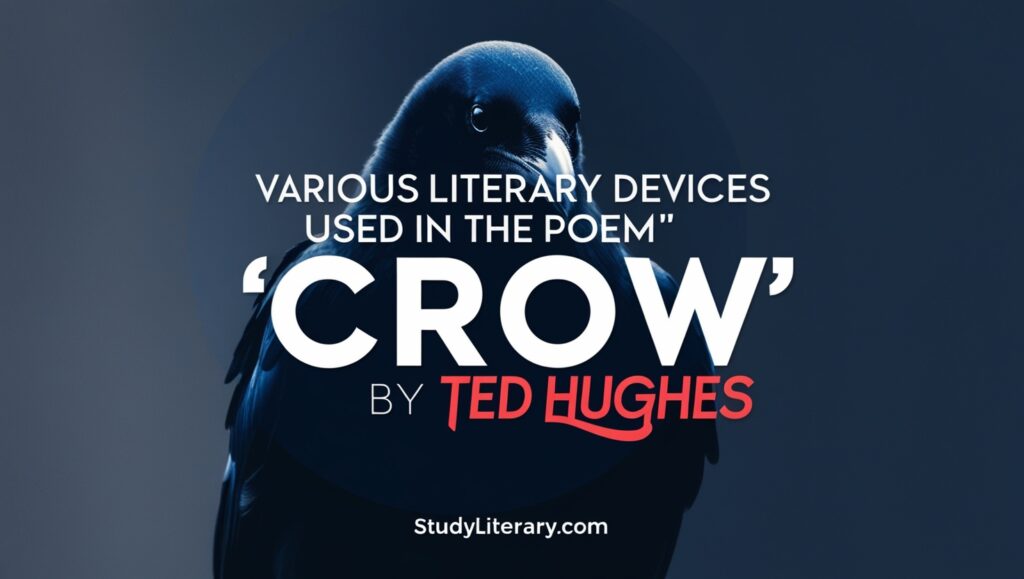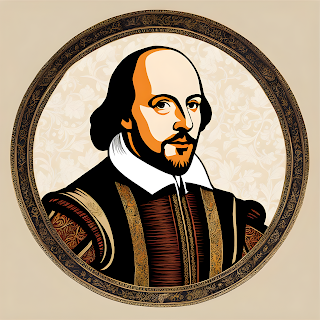
Various Literary Devices Used in the poem CROW by Ted Hughes
Ted Hughes’ poem “Crow” is rich in literary devices that contribute to its vivid imagery, thematic depth, and symbolic complexity. The poem uses these devices to explore profound existential themes such as rebellion, transformation, and the struggle against cosmic forces. Below, I discuss the key literary devices used in the poem, illustrating how they enhance its overall meaning and impact.
1. Symbolism
Symbolism is a dominant device in the poem, particularly in the representation of the Crow and the Sun. The Crow itself is a symbol of chaos, defiance, and the darker aspects of existence. Traditionally, crows are associated with death, darkness, and omens, but in this poem, Hughes initially portrays the Crow as “white,” symbolizing purity, innocence, or an untainted state. The transformation of the Crow from white to black represents the journey from innocence to corruption, reflecting the consequences of rebellion and the loss of purity.
The Sun symbolizes unattainable ideals, cosmic order, and blinding purity. Crow’s attack on the Sun represents a rebellion against these ideals, attempting to destroy what is perceived as oppressive or out of reach. The Sun’s resistance to Crow’s assault, and its subsequent brightening, symbolizes the invincibility of certain cosmic forces and the futility of attempting to subvert them.
2. Imagery
Imagery plays a critical role in conveying the intense emotions and actions in the poem. Hughes uses vivid and often stark images to depict the Crow’s rebellion and transformation. For example, the lines “He clawed and fluffed his rage up” and “He aimed his beak direct at the sun’s centre” create a visual picture of Crow’s preparation for battle. The words “clawed” and “fluffed” evoke an image of a bird bristling in anger, heightening the sense of aggression and intensity. The image of Crow aiming his beak at the Sun’s center illustrates his direct, almost suicidal challenge to a force much greater than himself.
The transformation of Crow is depicted through stark visual imagery: “Crow returned charred black.” The word “charred” conveys the destructive effects of his rebellion, emphasizing the irreversible change that has taken place. This imagery not only highlights the physical transformation of Crow but also symbolizes the internal corruption that has occurred as a result of his defiance.
3. Irony
Irony is a key device that gives the poem its dark, ambiguous tone. The final lines, where Crow declares, “Up there, / Where white is black and black is white, I won,” are laden with irony. Crow claims victory in a realm where the natural order has been inverted—where purity is corrupted and corruption is pure. This inversion suggests that Crow’s victory is not a true triumph but rather a hollow one, achieved in a distorted, chaotic world where distinctions between good and evil, light and darkness, have collapsed. The irony lies in the fact that Crow’s “victory” is ultimately self-destructive; he has not overcome the Sun, but instead has been consumed by his own rebellion.
4. Paradox
Closely related to irony, paradox is another device used in the poem to convey the complex, contradictory nature of Crow’s struggle. The statement “Where white is black and black is white” is a paradox that encapsulates the inversion of values and meanings in Crow’s world. This paradox reflects the idea that in attempting to destroy the Sun (a symbol of perfection and purity), Crow has ended up in a world where the very concepts of light and darkness, good and evil, have lost their meaning. The paradoxical nature of Crow’s victory underscores the futility of his rebellion and the disorienting consequences of his actions.
5. Repetition
Repetition is used in the poem to emphasize key ideas and to build tension. The repeated references to whiteness in the opening lines—“the sun was too white,” “it glared much too whitely”—highlight Crow’s obsession with the purity and brightness of the Sun. This repetition intensifies the sense of discomfort and alienation that drives Crow to rebel. Later in the poem, the repetition of “brightened” in “But the sun brightened— / It brightened” underscores the Sun’s unassailable power and Crow’s failure to diminish it. The repetition reinforces the idea that the forces Crow is challenging are immutable and beyond his control.
6. Personification
Personification is used to attribute human qualities to the Crow and the Sun, turning them into symbolic representations of larger concepts. The Crow is depicted as a conscious being, capable of deciding, preparing, and attacking. By giving Crow human-like motivations and emotions, Hughes turns him into a symbol of defiance and rebellion, reflecting the darker impulses in human nature. The Sun, while not personified to the same extent, is depicted as an adversary that “brightened” in response to Crow’s attack, almost as if it is asserting its dominance. This personification adds a mythic quality to the poem, transforming the conflict into a cosmic battle between opposing forces.
7. Juxtaposition
Hughes uses juxtaposition to contrast opposing ideas and images throughout the poem. The transformation of Crow from white to black is a stark juxtaposition that symbolizes the shift from innocence to corruption. The juxtaposition of light and dark, white and black, is central to the poem’s exploration of dualities and contradictions. Additionally, the contrast between the destructive effects of Crow’s battle cry—“trees grew suddenly old, / Shadows flattened”—and the Sun’s subsequent brightening highlights the futility of Crow’s efforts. The juxtaposition of these images underscores the idea that despite Crow’s destructive power, the Sun remains unaffected, suggesting the indestructibility of certain ideals.
8. Metaphor
Metaphor is used throughout the poem to convey complex ideas in symbolic terms. The entire conflict between Crow and the Sun can be seen as a metaphor for the struggle between individual defiance and cosmic order. The Sun is a metaphor for unattainable ideals, perfection, or divine authority, while Crow represents the rebellious, chaotic forces that challenge these ideals. The transformation of Crow from white to black can be interpreted as a metaphor for the loss of innocence and the descent into corruption as a result of defiance.
9. Allusion
Hughes’ poem alludes to various mythic and archetypal themes, particularly in its depiction of the Crow as a trickster figure. In mythology, the trickster is often a rebellious character who challenges the gods and disrupts the natural order, only to face consequences. Crow’s battle with the Sun echoes these mythic narratives, positioning him as a figure who embodies both the creative and destructive aspects of rebellion. The poem’s allusion to these mythic themes gives it a timeless, universal quality, connecting Crow’s struggle to broader human experiences.
10. Ambiguity
Ambiguity is a significant device in the poem, leaving many aspects of Crow’s journey open to interpretation. The final lines are particularly ambiguous, with Crow’s declaration of victory raising questions about the nature of his success. Has Crow truly won, or is his victory merely a delusion? The ambiguity surrounding Crow’s transformation and the meaning of his “victory” invites multiple readings, reflecting the complexity and uncertainty of the themes Hughes is exploring.
Conclusion
Ted Hughes’ “Crow” is a masterful example of how literary devices can be used to convey deep thematic content and create a rich, multi-layered narrative. Through symbolism, imagery, irony, and other devices, Hughes presents a dark, enigmatic tale of rebellion, transformation, and the cost of challenging cosmic forces. The poem’s use of paradox, repetition, and juxtaposition enhances its exploration of dualities and contradictions, making it a compelling reflection on the nature of power, identity, and the human condition.

